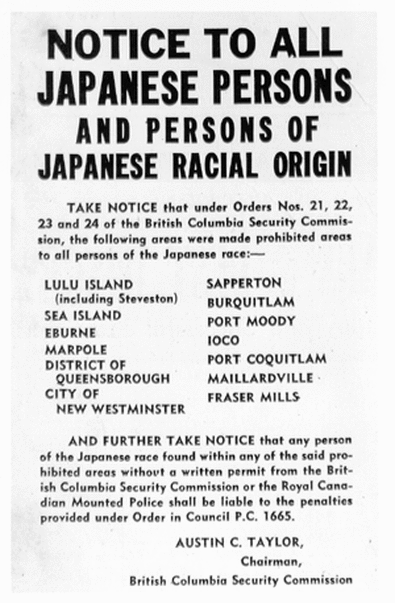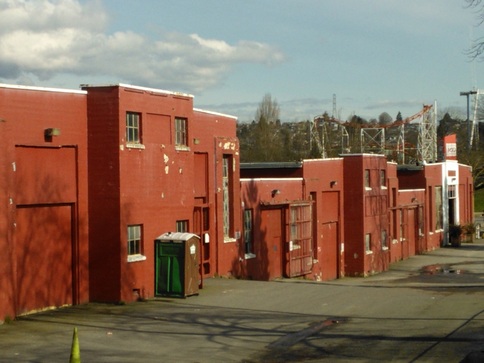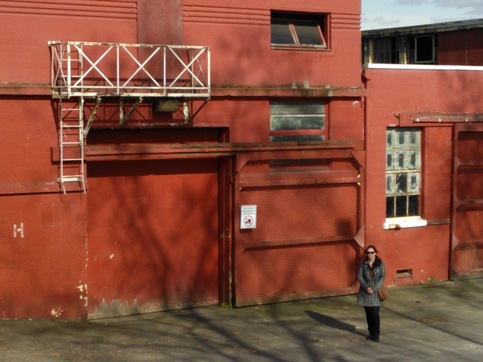Hastings Park Internment Centre
by Jon Harding
Unsurprisingly, the conditions in the PNE internment camp were bleak. The harshness afforded to Japanese-Canadians inside such camps extended far outside them: property rights were heavily restricted outside of the camps, and even if the people inside camps such as the one at the PNE were able to leave, they would find themselves without a means for survival. The Canadian government in 1943 assured Japanese-Canadians that their property would be held in trust and would be returned to them, in some form, once they resettled elsewhere in Canada. This promise went unfulfilled, and Japanese-Canadian property was generally sold once confiscated, often for pennies on the dollar. The confiscation and sale was strongly defended by the Canadian Prime Minister at the time, William Lyon Mackenize King, and his attitude along with the scale of the property and business confiscation that occurred makes it hard to believe that the Canadian government was not at least partially motivated by economic reasoning. It is hard to say whether the acquisition of Japanese-Canadian property and businesses was an extension of the same xenophobic tendencies that caused internment in the first place, or whether that acquisition had a more pragmatic basis, and the Canadian government simply viewed that portion of Japanese internment as an opportunity to enrich “Canadians” in the narrowest sense. Their property and businesses sold, many Japanese-Canadians were compelled to move east. Notable Japanese-Canadian academic and activist David Suzuki’s early life was characterized by events much like these.
|
The Japanese internment camp at the PNE is important not only for the deplorable acts committed in the process of keeping people contained there, but also for what it symbolizes. Lurid documentation and stories about European concentration camps such as Auschwitz abound, but much less attention is paid in Canada to a domestic manifestation of the same sentiments that caused atrocities to be committed in Europe against Jews, Gypsies, Communists, and other groups.
The fact that the barns at the PNE are allowed to stand and create a living material culture to be studied is, in itself, insufficient. The delay between the end of Japanese internment and the relatively recent commemoration of the site indicates that the buildings formerly used to house Japanese-Canadians were initially allowed to remain standing because they could be repurposed into being—or perhaps more accurately returned to the state of being—buildings meant to hold livestock and equipment. The commemorative objects currently in place—the Momiji Gardens, a plaque specifically dedicated to those interned at the PNE—are a good start, but are insufficient. The same xenophobic views and tendencies that we as a country vilify as anachronistic and horrifying were institutionalized and put into practice in Canada in the very recent past. An appropriate way to commemorate and recognize the atrocities committed against Japanese-Canadians not only at the PNE, but throughout western Canada is through awareness. Unfortunately, because of the way the barns at the PNE have been repurposed, we cannot viscerally experience the conditions faced by Japanese-Canadians interned there. An adequate substitute would be to redesign the education of World War II in high school and post-secondary schools not as a series of battles and events spread throughout the landscape, but rather a system of beliefs and competing worldviews that conspired to create atrocities all over the world, some of which were committed uncomfortably close to home. |
|
Further Reading
http://en.wikipedia.org/wiki/Japanese_Canadian_internment
http://en.wikipedia.org/wiki/Japanese_American_internment
http://en.wikipedia.org/wiki/David_Suzuki#Early_life
http://www.insidevancouver.ca/2010/09/24/hidden-gems-inside-the-sanctuary-at-hastings-park-pne/
http://www.yesnet.yk.ca/schools/projects/canadianhistory/camps/internment1.html
http://vancouveropera.blogspot.ca/2012/12/pne-livestock-building-plaque.html
Irons, Peter. Justice at War: The Story of the Japanese-American Internment Cases. University of California Press, 1993.
Nakano, Takeo Ujo, and Leatrice Nakano. Within the barbed wire fence: a Japanese man's account of his internment in Canada. Vol. 2. Halifax, NS: Goodread Biographies, 1983.
Roberts-Moore, Judith. "Establishing recognition of past injustices: uses of archival records in documenting the experience of Japanese Canadians during the Second World War." Archivaria 1.53 (2002). (http://journals.sfu.ca/archivar/index.php/archivaria/article/view/12837/14056 )http://en.wikipedia.org/wiki/Japanese_Canadian_internment
http://en.wikipedia.org/wiki/Japanese_Canadian_internment
http://en.wikipedia.org/wiki/Japanese_American_internment
http://en.wikipedia.org/wiki/David_Suzuki#Early_life
http://www.insidevancouver.ca/2010/09/24/hidden-gems-inside-the-sanctuary-at-hastings-park-pne/
http://www.yesnet.yk.ca/schools/projects/canadianhistory/camps/internment1.html
http://vancouveropera.blogspot.ca/2012/12/pne-livestock-building-plaque.html
Irons, Peter. Justice at War: The Story of the Japanese-American Internment Cases. University of California Press, 1993.
Nakano, Takeo Ujo, and Leatrice Nakano. Within the barbed wire fence: a Japanese man's account of his internment in Canada. Vol. 2. Halifax, NS: Goodread Biographies, 1983.
Roberts-Moore, Judith. "Establishing recognition of past injustices: uses of archival records in documenting the experience of Japanese Canadians during the Second World War." Archivaria 1.53 (2002). (http://journals.sfu.ca/archivar/index.php/archivaria/article/view/12837/14056 )http://en.wikipedia.org/wiki/Japanese_Canadian_internment



